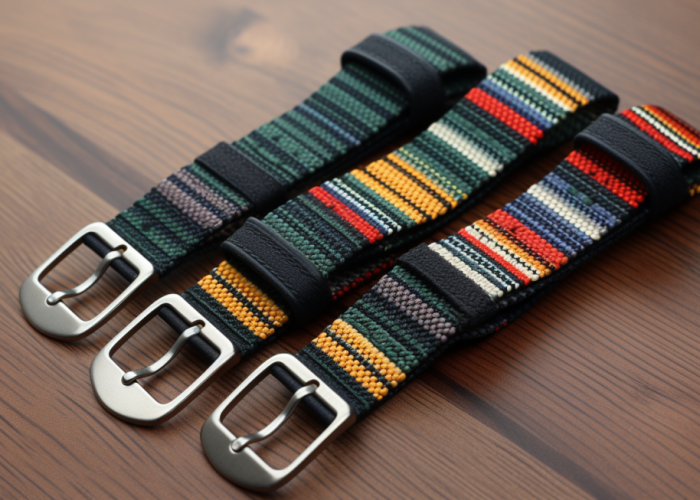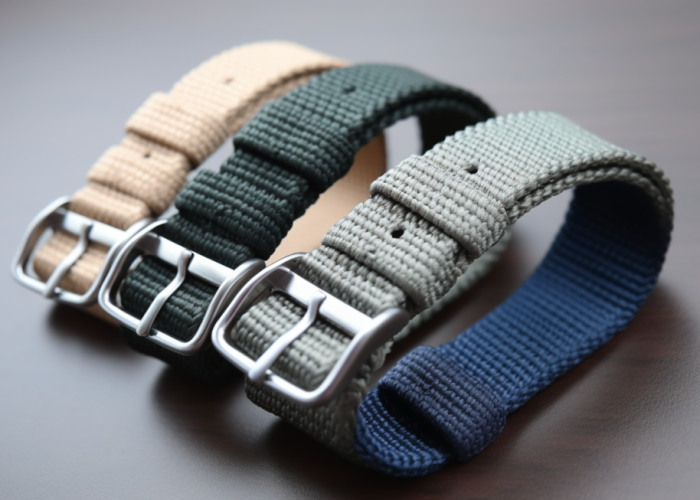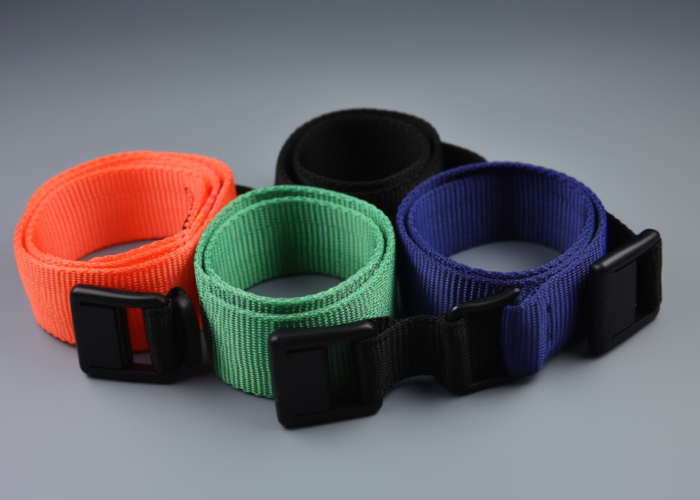As a custom webbing manufacturer specializing in tailor-made solutions, we frequently receive inquiries from watch brands and product developers asking about nylon watch strap specifications, performance characteristics, and material selection criteria. This comprehensive analysis addresses the most common technical questions we encounter, helping you make informed design decisions for your timepiece products.
Nylon watch straps are high-performance woven polyamide bands that provide superior tensile strength (up to 6,000 lbs/in²), excellent water resistance (0.8% absorption), and exceptional durability for timepiece applications.
Developing watch straps? Learn how nylon’s properties, construction, and limits impact performance—plus get expert guidance on custom webbing solutions.


Webbing manufacturing expert with 15+ years of experience helping product developers build high-performance straps for industrial, medical, and outdoor use.
Nylon watch straps require a minimum tensile strength of 2,000-3,000 lbs/in² for standard consumer applications, while military-grade specifications reach 6,000 lbs/in² for tactical and extreme-use timepieces. This strength ensures secure wrist retention under normal stress conditions, including sudden impacts, athletic activities, and equipment snagging scenarios.
Key Tensile Strength Specifications:
Production quality data across outdoor gear manufacturers shows that straps below 3,000 lbs/in² consistently fail at hardware connection points during climbing stress tests, while military-grade variants maintain structural integrity through extreme use. Nylon’s superior performance stems from long polyamide chains that distribute stress across the weave pattern, preventing localized failure points common in other materials. Performance comparisons demonstrate minimal degradation (less than 10% loss) compared to polypropylene alternatives that experience 8-20% strength reduction over equivalent use periods.
Diving watch manufacturers report that inadequate tensile strength leads to expensive warranty claims when straps fail during underwater activities, creating both safety hazards and costly replacements. Military contractor specifications consistently require 6,000 lbs/in² ratings after field incidents where lower-strength straps failed during equipment entanglement scenarios.
Design Takeaway: Specify minimum 3,000 lbs/in² tensile strength for sports and outdoor watches to prevent warranty issues. For luxury timepieces where cost optimization is prioritized, 2,000 lbs/in² provides adequate security for daily wear scenarios.
Nylon watch straps are highly water-resistant with only 0.8% water absorption compared to 7% for cotton alternatives, making them excellent for sports watches and aquatic activities. While not technically “waterproof,” their low absorption rate and quick-drying properties provide superior performance for swimming, diving, and water sports applications.
Water Resistance Performance:
Laboratory testing on diving watch accessories shows nylon straps maintain structural integrity after 1,000+ hours of saltwater immersion, while swimming pool evaluations demonstrate zero fiber breakdown from chlorine exposure. The synthetic polyamide structure naturally repels moisture, preventing bacterial growth and odor development that plague leather alternatives. Quick-drying characteristics allow comfortable rewearing within 30 minutes of water activity completion.
Surf and sailing watch brands prioritize nylon specifically for its moisture immunity—unlike leather that cracks when repeatedly wetted, or metal bracelets that trap water against skin causing irritation. Aquatic sports applications benefit from nylon’s ability to function identically whether dry or saturated, eliminating performance variables during competition.
Design Takeaway: For any sports watch targeting water activities, nylon’s 0.8% absorption rate ensures consistent user comfort and eliminates moisture-related warranty issues. Swimming and diving applications particularly benefit from salt water immunity and rapid drying properties.

Nylon watch straps maintain 95% elasticity retention at temperatures as low as -40°F (-40°C) and remain stable up to 200°F (93°C), making them suitable for extreme environment timepieces. This temperature range covers virtually all human activity scenarios, from arctic conditions to desert heat exposure.
Temperature Performance Range:
ISO 788 protocol evaluations reveal nylon’s exceptional cold weather flexibility compared to rubber compounds that become brittle below 20°F (-6°C). The polyamide molecular chains maintain elasticity even in extreme cold, preventing the cracking failure modes common in natural materials. Heat tolerance testing shows gradual stiffening above 200°F, though normal wearing conditions rarely exceed 120°F even in intense sun exposure.
Arctic expedition timepieces require materials that won’t fail during sub-zero operations, while desert professional watches need heat stability during prolonged outdoor work. Adventure sports applications from mountaineering to polar research demand temperature-immune accessories that won’t compromise equipment function when conditions turn extreme.
Design Takeaway: Outdoor adventure and professional-grade watches benefit from nylon’s -40°F to 200°F operational window, eliminating temperature-induced failures. Choose nylon construction when targeting extreme sports markets, professional outdoor work, or expedition equipment where climate variability is expected.
NATO single-pass construction (1.2mm thickness) offers heritage appeal and security, while Zulu multi-ring design (2.0mm thickness) provides superior weight distribution, and Perlon breathable weave delivers maximum comfort for extended wear. Your brand positioning and target market determine the optimal construction choice.
Construction Comparison:
Market research across watch segments reveals construction drives consumer perception: collectors associate NATO with authenticity and historical significance, professional divers prioritize Zulu’s comfort during extended underwater operations, and lifestyle consumers favor Perlon’s breathability for office and casual environments. Construction thickness communicates value positioning—robust profiles suggest durability focus, while refined dimensions indicate sophistication emphasis.
NATO appeals to enthusiasts seeking genuine military connections and storytelling opportunities for marketing campaigns. Zulu attracts performance-oriented buyers who value functional advantages over historical associations. Perlon targets everyday users prioritizing comfort and skin-friendly materials for prolonged wearing periods.
Construction Selection Guide: Heritage brands benefit from NATO’s authentic military origins, diving specialists should choose Zulu for underwater comfort advantages, lifestyle brands optimize customer satisfaction with Perlon’s breathable design. Consider manufacturing capabilities when selecting—complex constructions require specialized equipment and expertise.

Consumer-grade nylon watch straps typically last 2-3 years with daily wear, while professional-specification versions provide 5+ years of service under regular use conditions. Durability varies significantly based on activity level, care practices, and initial construction quality.
Lifespan Factors:
Customer service data from watch retailers shows replacement patterns clustered around specific timeframes: casual wearers report strap changes after 2.5-3 years due to aesthetic preferences rather than failure, while active users require replacements every 1.5-2 years from accumulated wear stress. The nylon fabric itself rarely fails—buckle mechanisms and stitching deteriorate first from repeated stress cycles.
Activity intensity directly correlates with replacement frequency: desk workers achieve maximum longevity through minimal physical stress, athletes experience faster degradation from sweat exposure and movement friction, outdoor professionals face environmental challenges including UV radiation and abrasive contact. Proper cleaning and rotation between multiple straps significantly extends individual strap lifespan.
Longevity Planning: Budget replacement intervals based on user lifestyle—casual wearers every 3 years, active users every 2 years. Specify reinforced hardware connections for extended durability, or design modular systems allowing strap replacement without complete product obsolescence.

Nylon watch straps deliver superior performance with 6,000 lbs/in² strength, 0.8% water absorption, and extreme temperature stability. Systematic selection prioritizes application requirements: tensile strength for safety, construction type for brand positioning, durability planning for market expectations. We provide custom nylon watch strap manufacturing and engineering consultation for optimized timepiece designs.
Nylon is hypoallergenic and non-reactive for most users. The synthetic polyamide fibers don’t harbor bacteria like natural materials, and quick-drying properties prevent moisture buildup that causes skin irritation.
Choose Zulu construction with 2.0mm thickness for enhanced weight distribution underwater. Specify salt water resistance testing and ensure hardware uses marine-grade stainless steel to prevent corrosion during extended aquatic use.
Yes, nylon accepts dye sublimation for custom colors and patterns. Solution-dyed fibers provide superior color fastness compared to post-production dyeing, with 864+ color combinations possible through custom manufacturing processes.
Nylon typically costs 40-60% less than genuine leather and 70-80% less than metal bracelets while providing superior durability and environmental resistance, making it cost-effective for both manufacturing and end-user replacement cycles.
Specify ASTM D5034 for tensile strength verification, ISO 788 for temperature resistance, and request 50,000+ flex cycle testing. Include salt water immersion and UV exposure protocols for outdoor applications.
Military-grade straps meet G10 specifications with 6,000 lbs/in² tensile strength and 5+ year service life, while consumer versions typically offer 2,000-3,000 lbs/in² strength and 2-3 year durability for cost optimization.